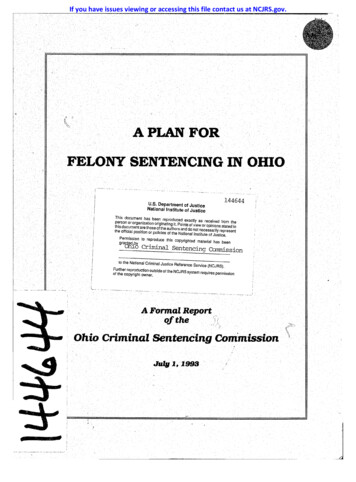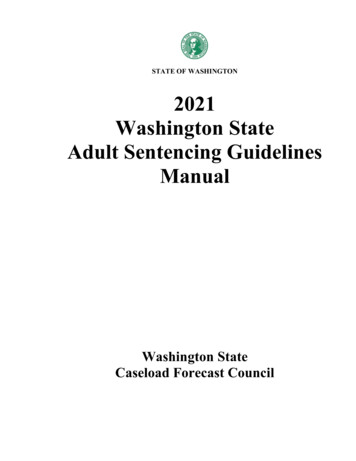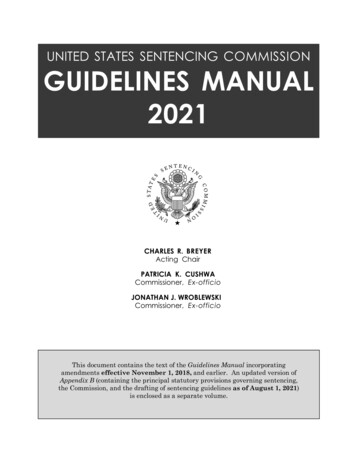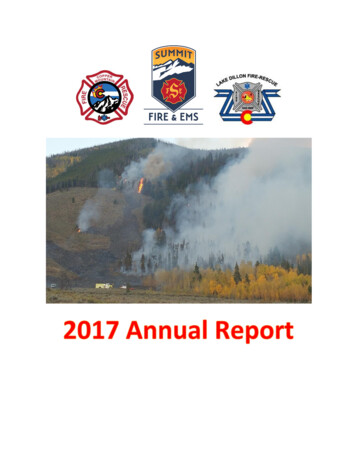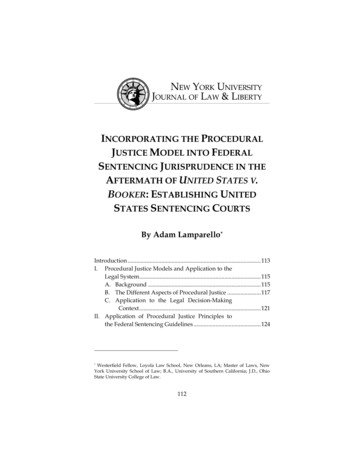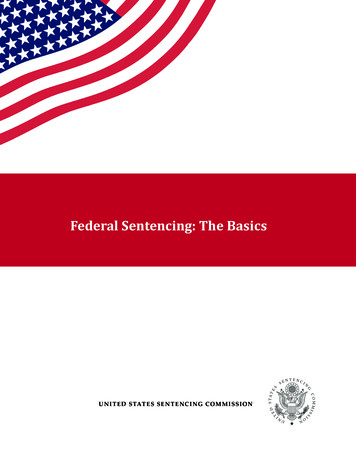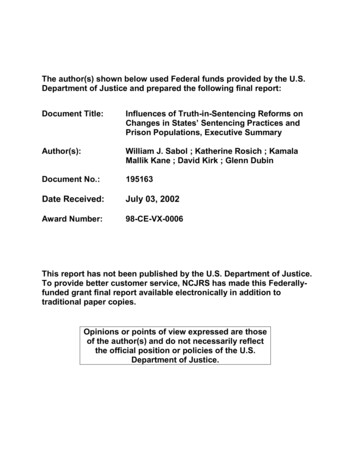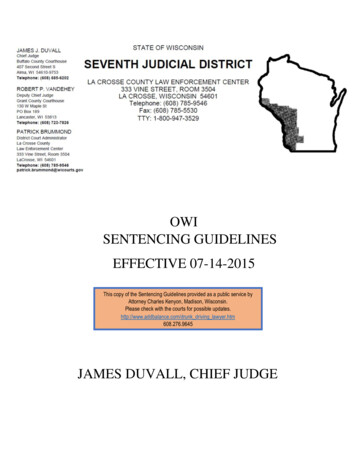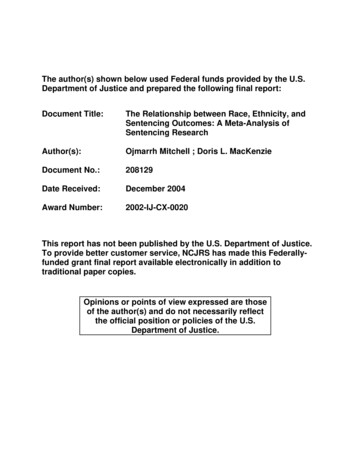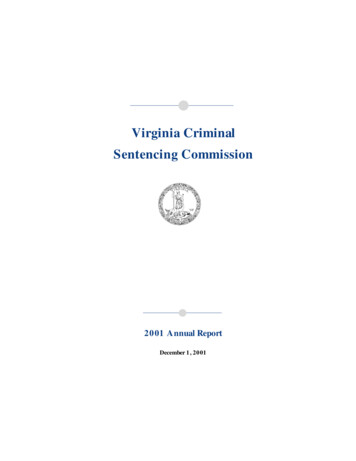
Transcription
Virginia CriminalSentencing Commission 2001 Annual ReportDecember 1, 2001
Virginia Criminal Sentencing Commission MembersAppointed by the Chief Justice of the Supreme Court and Confirmed by the General AssemblyJudge Ernest P. GatesChairman, Chesterfield CountyAppointments by the Chief Justice of the Supreme CourtJudge Robert W. Stewart, Vice Chairman, NorfolkJudge F. Bruce Bach, Fairfax CountyJudge George E. Honts, III, FincastleJudge J. Samuel Johnston, RustburgJudge William T. Newman, Arlington CountyJudge Donald A. McGlothlin, Jr., Dickenson CountyAttorney GeneralThe Honorable Randolph A. Beales, Richmond(Frank S. Ferguson, Attorney General’s Representative)Senate AppointmentsReverend George F. Ricketts, Mathews CountyMark C. Christie, RichmondHouse of Delegates AppointmentsArnold R. Henderson, RichmondDouglas L. Guynn, HarrisonburgThe Honorable Howard E. Gwynn, Newport NewsGovernor's AppointmentsThe Honorable Gary K. Aronhalt, RichmondJo Ann Bruce, MadisonJudge Henry E. Hudson, Fairfax CountyThe Honorable William G. Petty, Lynchburg The Staff of the CommissionRichard P. Kern, Ph.D., DirectorMeredith Farrar-Owens, Associate DirectorThomas Y. Barnes, Research AssociateTama S. Celi, Research AssociateJames C. Creech, Ph.D., Research Unit ManagerJody T. Fridley, Training/Data Processing Unit ManagerAngela S. Kepus, Training AssociateShirley F. Shepperson, Data Processing SpecialistCarolyn A. Williamson, Data Quality Control AssociateThe design and layout of the 2001 Annual Report of theVirginia Criminal Sentencing Commission was created by Judith Ann Sullivan.
Commonwealth of VirginiaHON. ERNEST P. GATESCHAIRMANRICHARD P. KERN, PH.D.DIRECTOR100 NORTH NINTH STREETRICHMOND, VIRGINIA 23219TEL. (804) 225-4398FAX (804) 786-3934Supreme Court of VirginiaVirginia Criminal Sentencing CommissionDecember 1, 2001To:The Honorable Harry L. Carrico, Chief Justice of VirginiaThe Honorable James S. Gilmore, III, Governor of VirginiaThe Honorable Members of the General Assembly of VirginiaThe Citizens of VirginiaSection 17.1-803(10) of the Code of Virginia requires the Virginia Criminal Sentencing Commission to report annually upon its work and recommendations. Pursuant to this statutory obligation, we respectfully submit for your review the 2001 Annual Report of the CriminalSentencing Commission.This report details the work of the Commission over the past year and outlines the ambitiousschedule of activities that lies ahead. The report provides a comprehensive examination of judicialcompliance with the felony sentencing guidelines for fiscal year 2001. The Commission’s recommendations to the 2002 session of the Virginia General Assembly are also contained within this report.The Commission wishes to sincerely thank those of you in the field whose diligent work with theguidelines enables us to produce this report.Respectfully submitted,Ernest P. Gates, Chairman
Table of ContentsIntroductionOverview . 1Commission Profile . 1Activities of the Commission . 1Monitoring and Oversight . 2Training and Education . 2Community Correction Revocation Data System . 3Projecting Prison Bed Space Impact of Proposed Legislation . 4Substance Abuse Screening and Assessment for Offenders . 5Prison and Jail Population Forecasting . 5Review of Rape Sentencing Guidelines . 6Comprehensive Review of Sentencing Guidelines . 7Guidelines ComplianceIntroduction . 9Case Characteristics . 9Compliance Defined . 12Overall Compliance with the Sentencing Guidelines . 13Dispositional Compliance . 13Durational Compliance . 14Reasons for Departure from the Guidelines . 15Compliance by Circuit . 17Virginia Localities and Judicial Circuits . 18Compliance by Sentencing Guidelines Offense Group . 20Specific Offense Compliance . 23Compliance Under Midpoint Enhancements . 25Juries and the Sentencing Guidelines . 28Methamphetamine StudyIntroduction . 31Study Methodology . 32Methamphetamine Seizures . 32Methamphetamine Use Among Arrestees . 35Methamphetamine Convictions . 36Relative Prevalence of Methamphetamine . 38
Table of Contents continuedMethamphetamine Study continuedQuantity of Drug in Methamphetamine Sales . 38Quantity of Methamphetamine and Sentencing Outcome . 40Virginia Sentencing Guidelines . 41Mandatory Penalties for Schedule I or II Drug Offenses . 43Comparing Virginia and Federal Sentencing Guidelines . 45Commission Deliberations . 47References . 48Nonviolent Offender Risk AssessmentIntroduction . 49Development of the Risk Assessment Instrument . 49Pilot Program . 50NCSC Evaluation . 52Commission Pilot Site Review . 54Validation Study . 55Methodology . 55Models . 57Validation Model Factors . 60Future of Nonviolent Risk Assessment . 62Impact of Truth-in-SentencingIntroduction . 63Impact on Percentage of Sentence Served for Felonies . 63Impact on Incarceration Periods Served by Violent Offenders . 65Impact on Projected Prison Bed Space Needs . 71Impact on Alternative Punishment Options . 72Summary . 74Recommendations of the CommissionIntroduction . 75Recommendations 1-4 . 76Appendices . 85
11IntroductionIntroductionOverviewCommission ProfileThis is the seventh annual report of the Virginia CriminalThe Virginia Criminal Sentencing Commission is comprisedSentencing Commission. The report is organized intoof 17 members as authorized in Code of Virginia §17.1-802.six chapters.The Chairman of the Commission is appointed by the ChiefJustice of the Supreme Court of Virginia, must not be an ac-The first chapter provides a general profile of the Commis-tive member of the judiciary and must be confirmed by thesion and its various activities and projects undertaken duringGeneral Assembly. The Chief Justice also appoints six judges2001. The second chapter includes the results of a detailedor justices to serve on the Commission. Five members of theanalysis of judicial compliance with the discretionary sen-Commission are appointed by the General Assembly: thetencing guidelines system as well as other related sentenc-Speaker of the House of Delegates designates three mem-ing trend data. In the third chapter of this report, the resultsbers, and the Senate Committee on Privileges and Electionsof the Commission’s special study on methamphetamineselects two members. The Governor appoints four mem-offenses are presented. The fourth chapter contains a re-bers, at least one of whom must be a victim of crime or aport on the Commission’s pilot project involving an offenderrepresentative of a crime victims’ organization. The finalrisk assessment instrument for use with nonviolent felons.member is Virginia’s Attorney General, who serves by virtueThe fifth chapter describes the impact of the no-parole/truth-of his office. In the past year, Virginia’s Attorney General,in-sentencing system that has been in effect for any felonyMark Earley, designated Deputy Attorney General Frankcommitted on or after January 1, 1995. The final chapterFerguson as his representative at Commission meetings.presents the Commission’s recommendations for 2002.The Virginia Criminal Sentencing Commission is an agencyof the Supreme Court of Virginia. The Commission’s officesand staff are located on the Fifth Floor of the Supreme CourtBuilding at 100 North Ninth Street in downtown Richmond.Activities of the CommissionThe full membership of the Commission met four times inArt Here2001: March 19, June 18, September 10 and November 5.The following discussion provides an overview of some ofthe Commission’s actions and initiatives during the past yearthat are not discussed in detail elsewhere within this report.
22001 Annual ReportMonitoring and OversightTraining and EducationAs required by §19.2-298.01 of the Code of Virginia, sen-The Commission continuously offers training and educationaltencing guidelines worksheets must be completed in allopportunities in an effort to promote the accurate completionfelony cases for which guidelines exist and judges must an-of sentencing guidelines. Training seminars are designed tonounce during court proceedings that the forms have beenappeal to the needs of attorneys for the Commonwealth andreviewed. After sentencing, the guidelines worksheets mustprobation officers, the two groups authorized by statute tobe signed by the judge and become a part of the officialcomplete the official guidelines for the court. The seminarsrecord of each case. The clerk of the circuit court is respon-also provide defense attorneys with a knowledge base tosible for sending the signed worksheets to the Commission.challenge the accuracy of guidelines submitted to the court.Having all sides equally trained in the completion of guide-The Commission’s staff reviews the guidelines worksheetslines worksheets is essential to a system of checks and bal-as they are received to ensure that the forms have beenances that ensures the accuracy of sentencing guidelines.completed accurately. When problems are detected on asubmitted form, it is sent back to the sentencing judge forIn 2001, the Commission provided sentencing guidelinescorrective action. Since the conversion to the truth-in-assistance in a variety of forms: training and education semi-sentencing system involved newly designed forms andnars, assistance via the hot line phone system, and publica-new procedural requirements, previous annual reportstions and training materials. The Commission offered 47documented a variety of worksheet completion problems,training seminars in 22 different locations across the Com-including missing judicial departure explanations and con-monwealth. This year the Commission staff developed andfusion over the post-release term and supervision period.presented three training seminars: an introduction for newFamiliarization with the new system and ongoing feedbackusers of guidelines; a refresher course to address errors infrom the Commission’s review process have reduced thethe completion of guidelines and a “what’s new” seminarnumber of errors detected during the past year.focusing on changes effective July 1, 2001. All three seminars included a significant component on the sex offenderOnce the guidelines worksheets are reviewed and deter-risk assessment instrument implemented this year.mined to be complete, they are automated and analyzed.Principally, the automated guidelines database is used toThe Commission attempted to offer seminars in sites conve-examine judicial compliance with sentencing guidelinesnient to the majority of guideline users. The sites for theserecommendations. This analysis is conducted and pre-seminars included a combination of colleges and universi-sented to the Commission on a quarterly basis. The mostties, libraries, local facilities, courthouses and criminal justicerecent study of judicial compliance with the sentencingacademies. Seminars were offered at the following collegesguidelines is presented in the next chapter.and universities: Southwest Virginia Higher Education Center, Longwood College, Radford University, RappahannockCommunity College, Mountain Empire Community College,Germanna Community College, and Tidewater CommunityCollege. Other seminars were presented at the Departmentof Corrections’ Training Academy, Cardinal Criminal JusticeAcademy, City of Richmond’s Police Academy, ChesterfieldCounty Police Academy, and Central Virginia Criminal Justice Academy. Facilities such as the Virginia Transportationand Research Council in Charlottesville, Fairfax Government
3IntroductionComplex, Winchester Parks and Recreation, Danville Parksincorporated into the manual were based on user sugges-and Recreation, Virginia Beach Central Library, and Virginiations and comments, including additional instructions forBeach Fire Training Center were used in an effort to providecompleting guideline worksheets. In addition, there werea convenient and comfortable learning environment. Trainingseveral substantive changes to guidelines factors and in-sessions were also conducted at traditional locations such asstructions based on recommendations presented in thethe Arlington Circuit Court, Rockingham Circuit Court, Hamp-Commission’s previous annual report and approved byton General District Court, and the Virginia Supreme Court.the General Assembly.The Commission will continue to place a priority on providingsentencing guidelines training to any group of criminal justice professionals. The Commission regularly conductsCommunity CorrectionsRevocation Data Systemsentencing guidelines training at the Department of Corrections’ Training Academy as part of the curriculum for newUnder §17.1-803(7) of the Code of Virginia, it is the respon-probation officers. The Commission is also willing to providesibility of the Commission to monitor sentencing practicesan education program on guidelines and the no-parole sen-in felony cases throughout the Commonwealth. While thetencing system to any interested group or organization. If anCommission maintains a wide array of sentencing informa-individual is interested in training, he or she can contact thetion on felons at the time they are initially sentenced in circuitCommission and place his or her name on a waiting list.court, information on the re-imposition of suspended prisonOnce there is enough interest, a seminar will be held in atime for felons returned to court for violation of the conditionslocality convenient to the majority of individuals on the list.of community supervision has been largely unavailable andits impact difficult to assess. Among other uses, informationIn addition to providing training and education programs,the Commission staff maintains a hot line phone system(804.225.4398). The phone line is staffed from 7:45 a.m. toon cases involving re-imposition of suspended prison time iscritically important to accurately forecast future correctionalbed space needs.5:15 p.m., Monday through Friday, to respond quickly to anyquestions or concerns regarding the sentencing guidelines.With the sentencing reforms that abolished parole, circuitThe hot line continues to be an important resource for guide-court judges now handle a wider array of supervision viola-lines users around the Commonwealth. In 2001, Commis-tion cases. Judges now handle violations of post-releasesion staff has responded to thousands of calls through thesupervision terms following release from incarceration, for-hot line service.merly dealt with by the Parole Board in the form of paroleviolations. Furthermore, the significant expansion of alter-This year the manual was reorganized to make it more “userfriendly.” The instruction pages follow the flow of the worksheets and include headings that reflect the factor names onnative sanction options available to judges means that thejudiciary is also dealing with offenders who violate the conditions of these new programs.the worksheets. All tables are now conveniently located inthe Appendices section of the manual. Two new tables thatIn the fall of 1996, the Commission endorsed the implemen-identify all the felonies covered by sentencing guidelinestation of a simple one-page form to succinctly capture a fewalso are included in the Appendices. Many other changespieces of critical information on the reasons for, and theoutcome of, community supervision violation proceedings.
42001 Annual ReportEarly in 1997, the Commission teamed with the Departmentof Corrections to implement the data collection form. Proce-Projecting Prison Bed Space Impactof Proposed Legislationdures were established for the completion and submission ofthe forms to the Commission. The state’s probation officersPer §30-19.1:5 of the Code of Virginia, the Commission isare responsible for completing the top section of the formrequired to prepare impact statements for any proposedeach time they request a capias or a violation hearing withlegislation which might result in a net increase in periodsthe circuit court judge responsible for an offender’s supervi-of imprisonment in state correctional facilities. Such state-sion. The top half of the form contains the offender’s identi-ments must include details as to any increase or decreasefying information and the reasons the probation officer feelsin adult offender populations and any necessary adjustmentsthere has been a violation of the conditions of supervision.in guideline midpoint recommendations. Beginning JulyIn a few jurisdictions, the Commonwealth’s Attorney’s office2000, the Commission’s role in this process became morehas requested that prosecutors actively involved in the initia-pronounced, when it became the sole source for impacttion of violation hearings also be allowed to complete the topstatements on Virginia’s adult correctional bed space needs.section of the form for the court. The Commission has approved this variation on the normal form completion process.During the 2001 legislative session, the Commission prepared 146 separate impact analyses on proposed bills.The sentencing revocation form is then submitted to the judge.These proposed bills fell into four categories: 1) bills toThe judge completes the lower section of the form with hisincrease the felony penalty class of a specific crime;findings in the case and, if the offender is found to be in viola-2) proposals to add a new mandatory minimum penalty fortion, the specific sanction imposed. The sentencing revoca-a specific crime; 3) legislation that would create a newtion form also provides a space for the judge to submit anycriminal offense; and 4) bills that increase the penalty classadditional comments regarding his or her decision in the case.of a specific crime from a misdemeanor to a felony.The clerk of the circuit court is responsible for submitting thecompleted and signed original form to the Commission. TheThe Commission utilized its computer simulation-forecastingform has been designed to take advantage of advanced scan-program to estimate the projected impact of these proposalsning technology, which enables the Commission to quicklyon the prison system. In most instances, the projected im-and efficiently automate the information.pact and accompanying analysis of a bill was presented tothe General Assembly within 48 hours after the Commis-The Commission now includes training on the sentencingsion was notified of the bill’s introduction. These analysesrevocation form as part of the standard training provided towere also made available on the internet through the Legis-new probation officers at the Department of Corrections’lative Information System. When requested, the Commis-Training Academy.sion provided pertinent oral testimony to accompany theimpact analysis.The sentencing revocation data collection form was institutedfor all violation hearings held on or after July 1, 1997. TheCommission believes that the re-imposition of suspended timeis a vital facet in the punishment of offenders, and that data inthis area has, in the past, been scant at best. The communitycorrections revocation data system, developed under theauspices of the Commission, will serve as an important link inour knowledge of the sanctioning of offenders from initialsentencing through release from community supervision.
5IntroductionSubstance AbuseScreening and Assessment for OffendersIn 2001, the Interagency Committee began working with evaluators from the Department of Criminal Justice Services’Criminal Justice Research Center to gauge the impact ofDuring its 1998 session, the General Assembly passedthe screening and assessment program. Also in 2001, thesweeping legislation that requires many offenders, both adultInteragency Committee began work on a criminal sanction/and juvenile, to undergo screening and assessment for sub-treatment matrix for use in supervising adult offenders in thestance abuse problems related to drugs or alcohol. One as-community. The criminal sanction/treatment matrix currentlypect of this comprehensive new program is to provide judgesunder development is a tool that will compare the severity ofand other criminal justice professionals with as much informa-substance abuse problems with criminal risk assessment.tion as possible about the substance abuse problems of of-This process will assist courts and other criminal justicefenders they serve, so that sanctions can be tailored to ad-agencies to prioritize services to offenders with the mostdress both public safety issues and the treatment needs of theneed for, and potential to benefit from, the service. In addi-offender. Statewide implementation began January 1, 2000.tion, the Interagency Committee is continuing to refine confidentiality protocols to promote efficient exchange of informa-The law targets all adult felons and those Class 1 misde-tion among Virginia’s criminal justice agencies and treatmentmeanor drug offenders who are ordered to undergo super-organizations. Last year, in order to ensure that the programvision or participate in programming. Juvenile offenderscomplies with federal confidentiality requirements, the Inter-adjudicated for a felony, a Class 1 or 2 drug-related misde-agency Committee arranged for the Legal Action Center, ameanor, a drug-related charge that is the juvenile’s firstnationally recognized company specializing in confidentialityoffense or any other act for which a juvenile is ordered toissues, to conduct specialized training events in Virginia.undergo a social history also fall under the screening andassessment provisions. Under the new law, these offendersmust undergo a substance abuse screening. If the screen-Prison and Jail Population Forecastinging reveals key characteristics or behaviors likely related todrug use or alcohol abuse, a full assessment must be administered. Assessment is a thorough evaluation. Resultsof comprehensive assessment can be used for developingtreatment plans and assessing needs for services. Differentscreening and assessment instruments are used for the adultand juvenile populations. For adult felons, screening andSince 1987, Virginia has projected the size of its futureprison and jail populations through a process known as“consensus forecasting.” This approach combines technical forecasting expertise with the valuable judgment andexperience of professionals working in all areas of thecriminal justice system.assessment is conducted by the Department of Corrections’probation and parole office, while local offices of the Virginia Alco-While the Commission is not responsible for generating thehol Safety Action Program and local community-based probationprison or jail population forecast, it is included in the consen-agencies screen and assess adult misdemeanants. Juvenilesus forecasting process. During the past year, Commissionoffenders are screened and assessed by the court servicestaff members served on the technical committee that pro-units serving the Juvenile and Domestic Relations Court.vided methodological and statistical review of the forecastingwork. Also, the Commission’s Director served on the PolicyThe Interagency Drug Offender Screening and AssessmentCommittee was created in 1999 to oversee the implementation and subsequent administration of this program. ASentencing Commission staff member also serves onthe committee.Advisory Committee that oversees the development of theprison and jail forecasts.
62001 Annual ReportReview of Rape Sentencing GuidelinesAlthough rape cases with multiple victims are uncommon,concern was expressed about the difference in sentencingIn order to maintain the usefulness of the guidelines as arecommendations linked to the ages of the victims.tool for judges, the Commission continually monitors theguidelines system and any changes and trends in judicialsentencing patterns. In 2001, concerns over the Rapeguidelines, which cover rape, forcible sodomy and objectsexual penetration offenses, prompted a Commission member and a practicing attorney to ask the Commission to reexamine the existing guidelines for these crimes.Virginia’s sentencing guidelines largely reflect historicalsentencing patterns, which were later converted to historicalpatterns of time served when Virginia adopted truth-in-sentencing. The differences in the sentencing guidelines described above reflect historical patterns of punishment forrape offenders. The sentencing guidelines used today, however, also contain legislatively-mandated enhancements toTwo particular concerns were raised to the Commission.increase the sentence recommendations for offenders withFirst, the current Rape sentencing guidelines provide differ-current or prior convictions for violent crimes.ent sentencing recommendations for a rape of a victimunder the age of 13 than for a rape against a victim who isat least 13 years old. When the victim is under 13, theguidelines start at a recommendation of 9.8 years for anoffender with no prior criminal record, compared to 12.6years for an offender who raped an older victim (13 yearsold or more). The differen
The Virginia Criminal Sentencing Commission is comprised of 17 members as authorized in Code of Virginia §17.1-802. The Chairman of the Commission is appointed by the Chief Justice of the Supreme Court of Virginia, must not be an ac-tive member of the judiciary and must be confirmed by the General Assembly. The Chief Justice also appoints six .
